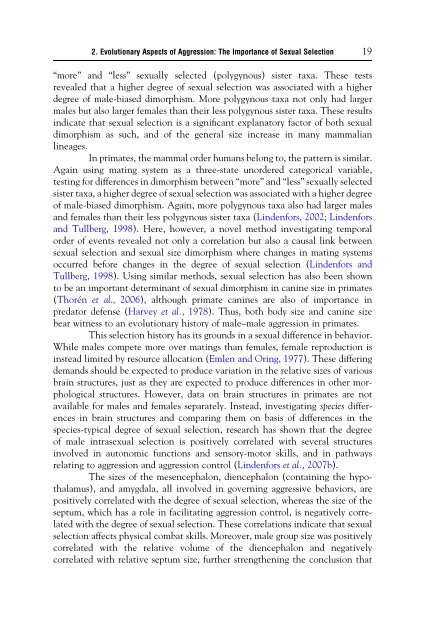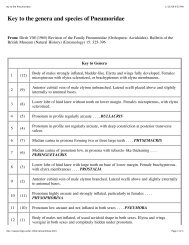full text - Caspar Bgsu - Bowling Green State University
full text - Caspar Bgsu - Bowling Green State University
full text - Caspar Bgsu - Bowling Green State University
Create successful ePaper yourself
Turn your PDF publications into a flip-book with our unique Google optimized e-Paper software.
2. Evolutionary Aspects of Aggression: The Importance of Sexual Selection 19<br />
“more” and “less” sexually selected (polygynous) sister taxa. These tests<br />
revealed that a higher degree of sexual selection was associated with a higher<br />
degree of male-biased dimorphism. More polygynous taxa not only had larger<br />
males but also larger females than their less polygynous sister taxa. These results<br />
indicate that sexual selection is a significant explanatory factor of both sexual<br />
dimorphism as such, and of the general size increase in many mammalian<br />
lineages.<br />
In primates, the mammal order humans belong to, the pattern is similar.<br />
Again using mating system as a three-state unordered categorical variable,<br />
testing for differences in dimorphism between “more” and “less” sexually selected<br />
sister taxa, a higher degree of sexual selection was associated with a higher degree<br />
of male-biased dimorphism. Again, more polygynous taxa also had larger males<br />
and females than their less polygynous sister taxa (Lindenfors, 2002; Lindenfors<br />
and Tullberg, 1998). Here, however, a novel method investigating temporal<br />
order of events revealed not only a correlation but also a causal link between<br />
sexual selection and sexual size dimorphism where changes in mating systems<br />
occurred before changes in the degree of sexual selection (Lindenfors and<br />
Tullberg, 1998). Using similar methods, sexual selection has also been shown<br />
to be an important determinant of sexual dimorphism in canine size in primates<br />
(Thorén et al., 2006), although primate canines are also of importance in<br />
predator defense (Harvey et al., 1978). Thus, both body size and canine size<br />
bear witness to an evolutionary history of male–male aggression in primates.<br />
This selection history has its grounds in a sexual difference in behavior.<br />
While males compete more over matings than females, female reproduction is<br />
instead limited by resource allocation (Emlen and Oring, 1977). These differing<br />
demands should be expected to produce variation in the relative sizes of various<br />
brain structures, just as they are expected to produce differences in other morphological<br />
structures. However, data on brain structures in primates are not<br />
available for males and females separately. Instead, investigating species differences<br />
in brain structures and comparing them on basis of differences in the<br />
species-typical degree of sexual selection, research has shown that the degree<br />
of male intrasexual selection is positively correlated with several structures<br />
involved in autonomic functions and sensory-motor skills, and in pathways<br />
relating to aggression and aggression control (Lindenfors et al., 2007b).<br />
The sizes of the mesencephalon, diencephalon (containing the hypothalamus),<br />
and amygdala, all involved in governing aggressive behaviors, are<br />
positively correlated with the degree of sexual selection, whereas the size of the<br />
septum, which has a role in facilitating aggression control, is negatively correlated<br />
with the degree of sexual selection. These correlations indicate that sexual<br />
selection affects physical combat skills. Moreover, male group size was positively<br />
correlated with the relative volume of the diencephalon and negatively<br />
correlated with relative septum size, further strengthening the conclusion that



